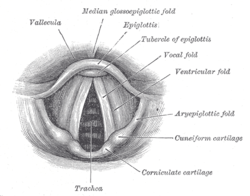Glottis
Opening between the vocal folds From Wikipedia, the free encyclopedia
The glottis (pl.: glottises or glottides) is the opening between the vocal folds[1] (the rima glottidis).[2] The glottis is crucial in producing sound from the vocal folds.
| Glottis | |
|---|---|
 Arytenoid cartilage | |
 Glottis positions | |
| Identifiers | |
| MeSH | D005931 |
| TA98 | A06.2.09.012 |
| TA2 | 3197 |
| FMA | 55414 |
| Anatomical terminology | |
Etymology
From Ancient Greek γλωττίς (glōttís), derived from γλῶττα (glôtta), variant of γλῶσσα (glôssa, "tongue").[3]
Function
Summarize
Perspective
Phonation
As the vocal folds vibrate, the resulting vibration produces a "buzzing" quality to the speech, called voice or voicing or pronunciation.
Sound production that involves moving the vocal folds close together is called glottal.[4] English has a voiceless glottal transition spelled "h". This sound is produced by keeping the vocal folds spread somewhat, resulting in non-turbulent airflow through the glottis.[4] In many accents of English the glottal stop (made by pressing the folds together) is used as a variant allophone of the phoneme /t/ (and in some dialects, occasionally of /k/ and /p/); in some languages, this sound is a phoneme of its own.
Skilled players of the Australian didgeridoo restrict their glottal opening in order to produce the full range of timbres available on the instrument.[5]
The vibration produced is an essential component of voiced consonants as well as vowels. If the vocal folds are drawn apart, air flows between them causing no vibration, as in the production of voiceless consonants.[6]
The glottis is also important in the Valsalva maneuver.
- Voiced consonants include /v/, /z/, /ʒ/, /d͡ʒ/, /ð/, /b/, /d/, /ɡ/, /w/.
- Voiceless consonants include /f/, /s/, /ʃ/, /t͡ʃ/, /θ/, /p/, /t/, /k/, /ʍ/, and /h/.
Additional images
References
External links
Wikiwand - on
Seamless Wikipedia browsing. On steroids.







